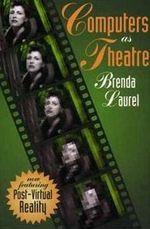
Chatbot listing, virtual agents, virtual assistants, chat bot directory, conversational agents, virtual human news, chatterbot list
NEWS: Chatbots.org survey on 3000 US and UK consumers shows it is time for chatbot integration in customer service!read more..
Computer as theatre

Laurel introduces to human-computer interaction designers the idea of the theatre as an interface metaphor for designing engaging computer applications. For Laurel, the theatre, drama and performance are useful for instructing the design of computer interfaces and human-computer interaction. Laurel argues that the computer is a medium rather than a tool that like the performance communication of theatre and drama, represents human thought and creates a space for imaginative experiment and expression.
| Laurel provides advice for interface design for human-computer interaction between interface agents and human beings, suggesting that interface agents should be designed based on dramatic characters rather than full-blown simulated human personalities, because dramatic characters can affect how human beings structure their thoughts, expectations and behaviours. If real-like characters are used, then people have certain expectations of real-like human communication. Laurel thereby provides instructive arguments to the design of virtual agents or artificial conversational agents or other role playing characters that interact with human beings and serve as interfaces to computer software systems. For Laurel, the agent characters of a system must pass a kind of anti-Turing test in order to be effective. It must be predictable, that persons can predict its actions with greater confidence and certainty than real people For those that question whether or not fictional characters can be used to represent serious communication, Laurel provides an argument. In a section of her book, Laurel discusses how the Greeks used drama, showing that people of the ancient world never used storytelling, myths or folklore for trivial or entertainment purposes, but instead they used it to convey important information about past, present or future. In discussing Aristotle’s philosophy, Laurel points out that historically poetry was used to represent serious action and that the ancients deemed art as useful for moral instruction. In Greek drama, mythology represented their world and humanity’s place in it. In other words, Laurel presents arguments that indicate that the fictitious performance of storytelling was useful in helping ancient people think about their societies and suggests that this approach can also inform modern computer-mediated communication. Laurel also provides an example of a project that features 3 agent characters/guides that provide multimedia access and narrative approach to navigating information in a database. The project also demonstrates the feasibility of using fictional characters to provide access to non-fiction information sources. In the project, the 3 agent characters or guides embodied 3 alternative perspectives about various topics in American history: a frontiersman, a Native American and a settler woman. These agents were designed based first person narrative account of incidents and topics related to the westward expansion in America. The sources of these accounts were derived from diaries and journals of real historical persons that experienced the expansion. The agents as such were cast as anthropomorphic storytellers performing stories in video format. These characters represented and provided context to information sources in the database. In order to establish the credibility of the agents, the agent performers through a video segment introducing themselves, describing their real-life professions and the source materials used and lessons learned. This established the agents as storytellers rather than fictitious characters, thereby reinforcing their credibility. The agents by representing varied point of views allows for multiple representations of events and knowledge, while giving the user various perspectives from which to explore the content and the knowledge in the knowledgebase. Laurel suggest that this approach is natural in that in the real world human beings do not “navigate to” information, but rather experience information coming to them from a variety of sources (page 183). Besides storytelling, Laurel describes the guides as recommending to users other information that the user might want to look at next in the database, based on the guide’s perspective and the information that is currently being displayed. The user can then click on the guide’s (hyperlinked) suggestion displayed in the guide’s suggestion box and the item or information will appear. Through the use of guide’s suggestion, information and action unfolds like an elaborate story created by one or more characters in collaboration with the user. Laurel suggests that this multimedia and narrative approach is natural in that it mirrors the kind of information that one receives in the real world, being varied, multisensory and having different effects on the person receiving the information. In addition, Laurel points out that the evidence suggests that information communicated as facts usually lose contexts and relationships, in contrast to information communicated as art or experience, which maintains and nourishes connections. In conclusion, Laurel introduces the idea of agents as storytellers or performers that can be used to tell stories based on characters experience and point of views, and make/offer recommendations about other information to look at in databases based on the guide’s point of view and user’s current interest or curiosity. |
New Comment
Only registered members are allowed to comment. or login
or login

Reviews
There is 1 review: